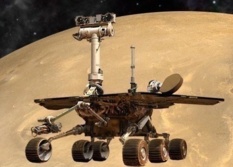A.J.S. Rayl • May 02, 2014
Mars Exploration Rovers Update: Opportunity Roves to Next Clay Mine
Sols 3619 - 3650
The Mars Exploration Rovers mission cruised toward the Martian spring renewed as Opportunity, powered-up and cleaner than it has been since its first winter on Mars, roved out of Cook Haven in April and continued the journey south at Endeavour Crater, along Murray Ridge toward the next set of outcrops harboring clay minerals and evidence of ancient warmer, wetter, habitable environments.
The veteran rover chalked up its 39th kilometer and put a total of nearly 500 meters (about 1640 feet) on its odometer in April, despite a glitch that put the robot into a safe mode for a couple of sols or Martian days and a right front wheel motor that drew slightly higher currents than normal for most of the month.
At the same time, the longest lived rover on another planet trundled into the space history books in another, distinctive way by providing the pictures and data needed to create the first life size, three-dimensional facsimile of a meteorite on Mars.
Cook Haven, the gentle swale or valley just off Murray Ridge – where Opportunity spent her sixth Martian winter investigating outcrop after outcrop of impact breccia hurled up and formed by whatever created Endeavour Crater some 4 billion years ago – was chosen as the rover's winter hideaway because it featured a number of north facing slopes. These slopes would allow the robot field geologist to soak up as much of the winter Sun in the northern sky as possible and rove at least a little, hopping from one slope, or "lily pad" as the team calls them, to the next to study different rocks and outcrops throughout winter.
"But then the 10th anniversary came and went and so did the dust on the array," said Michael Seibert, MER's lead flight director at the Jet Propulsion Laboratory (JPL), birthplace of all NASA's Mars rovers.
Turns out, Cook Haven was less of a science goldmine and more of a rover wash or a "scour zone," as Ray Arvidson, deputy principal investigator, of Washington University St. Louis (WUSTL), described it. Winds from the crater blow up slope in the little valley and then back down. As the winds circulated around the rover during the last several months, a little more dust was cleared nearly every sol from its solar arrays and on several occasions in February and March wind gusts boosted power by a notable 10 percent.
"It's welcome news, because it does relieve the future concern of the next winter and it bodes well for lots of energy to do lots of driving for lots of exploration over the next Martian year," said John Callas, MER project manager, of JPL.
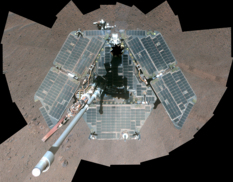
Shiny and clean again
Opportunity's self-portrait, taken with her panoramic camera (Pancam) through three different color filters from March 22 to March 24, 2014, the rover's Sols 3611 to 3613, shows effects of wind events that have cleaned much of the accumulated dust off her solar panels. "As a nice twist of fate, we got a cleaning during [this] most recent deck pan," said Mike Seibert, MER lead flight director. "If you look closely, the left wing is just a little bit dustier than the right wing. That's because we ended up with more cleaning during the three sols it took to collect all the pictures that go into a deck pan." This deck pan image is in false color to make differences in surface materials more easily visible.NASA / JPL-Caltech / Cornell / ASU
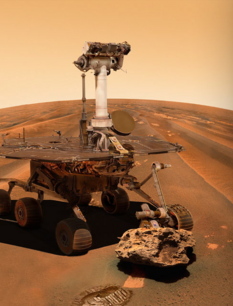
Oppy meets Block Island
This artist's rendering, put together by Glen Nagle, James Canvin, and Stuart Atkinson, each a member of UnmannedSpaceFlight.com, shows Opportunity at Block Island, the largest meteorite found to date on Mars, in 2009. With the data the rover sent home after a 360-degree inspection of the large watermelon-sized meteorite and the new technology of 3D printing, a team of researchers at JPL recently finished producing the world's first true facsimile of an object on another planet.NASA / JPL-Caltech / Cornell / ASU / G. Nagle, J. Canvin, S. Atkinson
A picture's worth a thousand words as the adage goes and the rover's latest self-portrait or "selfie" clearly shows that more than 10 years and 3 months into what was originally a 3-month mission, Opportunity is one clean machine. "We have a big print-out in our room on the MER floor at JPL and comparing the deck pan from Sol 323 – way back during the first year of the mission – and the deck pan we recently took after this cleaning, they look almost exactly the same," said Seibert. For the record, he looked back through all the data on Opportunity's power system and found that the last time the rover was this clean was Sol 1662, back in September 2008, just as the robot field geologist was about to leave Victoria Crater and begin the journey to Endeavour.
In any case, the amount of cleaning and the rate at which Opportunity was dusted during this Martian winter is "unprecedented," said Seibert. Even before the robot field geologist could complete its "selfie," it received another slight dusting, which is why the left solar array or winglet in the image appears just a tiny bit dustier than the right.
"From a dust-on-the-rover standpoint, it's turned the clock back by about six years," Seibert said. From a power perspective, this is the first winter since 2005 that Opportunity has been able to produce levels upward of 650 watt-hours. "Mars likes Opportunity," summed up Seibert.
The Cook Haven winds were so favorable that the Pancam apparently also got a little dusting, "on the front windows (not the lenses – they are sealed behind the front windows)," said Planetary Society President Jim Bell, Pancam lead, of Arizona State University (ASU). "We are working to try to figure out just how much." In fact, MER science team member Mark Lemmon, of Texas A&M University, is working on those calculations now.
The rover engineers took away another mission lesson during Opportunity's winter at Cook Haven. "Being on the rim of Endeavour Crater, we've seen that we're cleaner when we're on the windward side of Murray Ridge as opposed to the leeward side," said Seibert. "So, we have a hunch that when we need more cleaning next winter, we may be able to intentionally design where we explore and take Opportunity." For now however, the team's focus is on Opportunity exiting this winter and getting to the next destination.
When April dawned at Endeavour, the robot field geologist was producing 661 watt-hours of solar power under fairly clear skies and ready to rove on.
With her study on the McClure-Beverlin Escarpment at the far western edge of Cook Haven complete, Opportunity began the trek to the next set of clay mineral rich outcrops, driving south/ southwest on Sol 3621 (April 1, 2014) for 44 meters (144 feet). The robot field geologist paused mid-way to take some pictures of an exposed rock outcrop, and then two sols later, drove 16 meters (52 feet) in a clockwise arc around some obstacles in an approach to the outcrop dubbed Hoonah.
As Mars would have it, getting any closer would be difficult, so the MER team decided to have the robot field geologist document the outcrop in pictures, then back away and resume the journey south. Opportunity retraced some of her path with an 8.6-meter (28-foot) drive to the northwest on Sol 3625 (April 5, 2014), taking pictures of Hoonah and her own tracks for engineering evaluation purposes.
In the meantime, the MER team decided to send the rover to a nearby ridge top where she could get a more dramatic view of Endeavour's interior. On Sol 3628 (April 8, 2014) the robot drove 21 meters (69 feet) toward the ridge top, and two sols later pulled up to the vista point with an 8.6-meter (28-foot) drive. There, the robot field geologist could "see" the entire sweep of Endeavour's interior. Opportunity spent the next several sols scanning the view with her Panoramic Camera (Pancam) "eyes" and taking pictures.
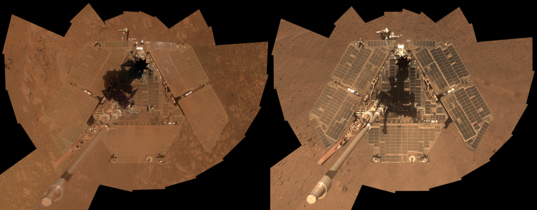
NASA / JPL-Caltech / Cornell / ASU
Two self-portraits, a dramatic difference
Opportunity took a self-portrait in January 2014, shown on the left, and then another in late March 2014 after it received a serious "dusting" in the first quarter of 2014 from the winds at its winter site, Cook Haven, shown on the right. With the cleaner arrays and lengthening winter days, the rover's solar arrays were generating more than 650 watthours per day in April 2014, compared to less than 375 watt-hours per day in January 2014. Both images are presented as vertical projections in approximate true color and were compiled from pictures the rover took with her panoramic camera (Pancam). The mast on which the Pancam is mounted does not appear in the image, though its shadow does.For all that Opportunity still has to give and to explore on the ancient Noachian terrain of Endeavour Crater, her fate – whether or not the mission will continue to be funded so that the rover can rove on – currently rests with NASA Headquarters and the bi-annual Senior Review.
The fact that the mission was taken out of NASA's Planetary Science budget and is to be funded from the President's Opportunity, Growth and Security Initiative – if the Senior Review approves it – caused concern at the annual Lunar & Planetary Science Conference (LPSC) held last month in Texas, as covered in the last issue of the MER Update. Since then, the MER team met NASA's April 11th deadline and submitted its proposal for a ninth mission extension to NASA. Now it's a waiting game.
Opportunity, meanwhile, kept on roving, undaunted as usual. On Sol 3635 (April 15, 2014), she drove 20 meters (66 feet) further to the south to a second ridge top spot where she completed panoramic imaging of Endeavour's interior. "With the cleaner front windows and the generally low level of atmospheric dust, photos of distant features have a crispness and a clarity that we only rarely get on Mars," Bell noted. The Pancam team's Endeavour Pan should be released in the next couple of weeks.
"Since then, it's been drive, drive, drive," said Arvidson. "We have been on the march to get to the montmorillonites, the aluminum-rich clay mineral outcrops that are about 600 meters to the south of Cook Haven," said Arvidson.
Showing her MER mettle, Opportunity was not to be stopped. During the third week of April and into the fourth, the robot field geologist drove six more times on Sols 3637, 3639, 3641, 3642, 3643, and 3644, (April 17, 19, 21, 22, 23, and 24, 2014), putting some 300 more meters (about 984 feet) on its odometer.

NASA / JPL-Caltech / Cornell / ASU
McClure-Beverlin Escarpment
The boulder-studded ridge in this image was dubbed the McClure-Beverlin Escarpment in February 2014 to honor Jack Beverlin and Bill McClure. These two engineers risked their lives to save NASA's second successful Mars mission, Mariner 6, on its launch pad on Feb. 14, 1969. Opportunity, looking toward the south, took the pictures for this image with her Pancam during her Sol 3527 (Dec. 25, 2013). As March turned to April 2014, the rover was climbing the slope in search of exposed rock layers. This false color version emphasizes subtle color differences among Martian surface materials. You can see a 3D version hereBut from the first drive in April, the electrical currents drawn by Opportunity's right front wheel actuator [motor] were persistently elevated. "We saw the right front wheel drive currents come up On Sol 3621 (April 1, 2014)," confirmed Seibert. "They were elevated but not dangerous, so we weren't concerned any of the current draws that we were seeing were going to be an immediate safety problem, but they were definitely different than what we've been seeing since we were driving on Solander Point. These have gone up and fluctuated and we're still trying to figure out what might have caused it or how to mitigate that and bring the right front wheel [motor] back to its typical levels."
This "hot" right front wheel motor is a known and intermittent issue and "it's always a concern," said Callas. "This is Grandma's knee getting a little more inflamed when she takes those long walks around the neighborhood."
To mitigate the issue, the MER ops team had it perform conditioning heating of the right-front drive actuator, basically warming it up to insure the motor's lubricant is properly distributed, when rover was parked and working on remote sensing. The engineers also decided to have Opportunity switch to driving backwards again, while the engineers continued to investigate the cause of the higher electrical draw on that motor.
At the moment, the engineers are thinking it may be the result of the aging properties of the actuator, or perhaps caused by extra friction in the gearbox from debris of some kind. "We're keeping a close eye on it and trying not to stress it when we don't need to," said JPL's Ashley Stroupe, a MER rover planner. "We're alternating driving backwards and forwards, depending on what seems to make the most sense for that particular sol.

Opportunity route map
This route map, produced by Eduardo Tesheiner, of UMSF.com, shows Opportunity's travels around Endeavor Crater through its Sol 3644 (April 24, 2014) and its approximate location. Tesheiner creates his route maps, which are regularly featured in the MER Update, from images taken by the HiRISE camera onboard the Mars Reconnaissance Orbiter (MRO) and then charts the rover's drives, in yellow, and labels the main waypoints and stops along the way (in red).NASA / JPL / UA / E. Tesheiner
While backwards driving at first seemed to "look better than forward driving," according to Seibert, "for the majority of the drives since April 1st, [the wheel motor] was giving us similar behavior no matter how we were driving and there was not much consistency to it. So it's still a mystery as to what is causing this elevated current and we're trying to understand what it is," he said.
Last time the issue occurred, the MER engineers found that it took some time of driving backwards before currents in that wheel actuator settled back down, said Callas. "Since we had been driving forward when it became aggravated again and since we have just switched to backwards driving, anecdotally, it may take some drives before it settles down," he said. "We are so far out of the experience with these actuators. We're in an unknown regime. We just don't know."
What they do know is that "it's not really affecting our capabilities right now," said Stroupe. "Opportunity is doing well and we're making good progress. Everything seems to be going as we hoped in terms of getting to these next clay minerals."
And in the mix of all that driving, on Sol 3639 (April 19, 2014), Opportunity completed her 39th kilometer (24 miles) since bouncing to a landing on January 24, 2004 Pacific Standard Time. Back then, she was only expected to drive 600 meters – and everyone would have been thrilled. Imagine.
A new personal best, kilometer 39 put Opportunity closer to taking the international title of most traveled rover on another planet, currently held by Lunokhod 2, a rover deposited on the Moon by the former Soviet Union in 1973. For decades, the Russian rover's record distance was logged and cited as 37 kilometers, but last year, with more recently acquired imagery taken by the Lunar Reconnaissance Orbiter Camera (LROC), a team of Russians reevaluated and revised the distance to 42+ kilometers.
An American team, led by MER science team member Brad Jolliff, of WUSTL, also a member of the LROC team, also reviewed the new LROC data and found that Lunokhod 2 had driven 41.8 meters, as reported in the MER Update June 2013 issue. The tracks are "remarkably well preserved" and can be readily seen in the images, Jolliff told the MER Update then. "But it's not easy to see everywhere it went."
The Russian and American teams are using map distance and not wheel turns to compare traverse distances. Whether it's 41.8 or 42.5 or even 43 kilometers, when Opportunity does rove past the distance record of Lunokhod 2, the MER team – as MER Principal Investigator Steve Squyres, of Cornell, has adamantly stated before – will recognize the Russian achievement of 40 years ago.
"What they did then was so amazing when you think about it," said Jolliff. "Landing a rover on the Moon, and then operating it remotely over more than one lunar day – surviving the extreme diurnal temperature swing – is still a very challenging thing to do today."
The latest word from Squyres is that the Russians and Americans are "still working out exactly what the numbers are."
You can be sure though that the MER team will count every valid centimeter and be absolutely certain Opportunity has crossed the milestone before making any announcement or claims to the title. "We will make sure that all parties concerned, including our Russian colleagues, agree that Opportunity has exceeded the L-2 traverse distance before we announce it," Jolliff confirmed by email April 30th.
That noted, the team is confident Opportunity "will be at the top of that list at some point," as Stroupe put it.
On Sol 3644 (April 24, 2014), the rover snapped pictures of a small crater the team named in honor of Lunokhod 2. But then Opportunity failed to write data to its Flash memory and executed a warm reboot. That meant the uplink commands for her final weekend of science in April failed to get onboard and the rover sat stationary until the following Monday. It wasn't a big loss. "We had planned to do a touch'n go with MI and APXS – on the first sol drive and on the second sol, touch," said Arvidson. "It was just a target of opportunity."
This isn't the first warm reboot that Opportunity has suffered while trying to write to her Flash memory and the rover engineers do have a procedure to deal with it. "We've seen this before, three or four times, very infrequently, so there doesn't seem to be any near term risk," said Seibert. "It's like something you'd see on an iPhone, a piece of bad memory and occasionally you'll try to write to it and it doesn't work. On Earth, you just have to close the app, but on Mars the rover has to deal with it autonomously. After [the rover's system] tries a few times, the flight software decides the next step is attempting to reboot," said Seibert. "The reboot puts us into our auto mode, a nice safe mode for the rover where it keeps talking to us and we can send commands to it."
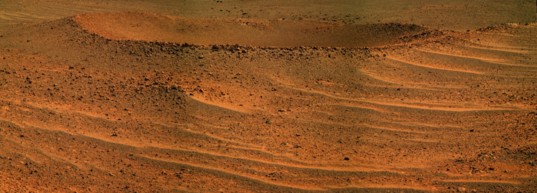
NASA / JPL-Caltech / Cornell / ASU / S. Atkinson
Lunokhod 2 Crater
Opportunity logged her 39th kilometer in April, but is still about 3 kilometers away from taking the title of most traveled rover on another planetary body, currently held by Lunokhod 2, a rover sent to the Moon by the former Soviet Union in 1973. MER team members are confident that Opportunity will soon surpass the Russian rover's 42- kilometer distance. At the same time, they acknowledge what the Russians achieved with Lunokhod 2. "It was the Moon and not Mars, and it's different. Still, when you consider the fact they were able to do what they did with 1973 technology, it was a truly magnificent accomplishment," said Steve Squyres, MER's principal investigator. "If one of the things that we can do with this is to shine a spotlight on what the Russians did accomplish in those days, that's a good thing." In the meantime, the team named a crater that Opportunity found in April in honor of the Russian rover and Stuart Atkinson processed it in rich Martian technicolor."This is an old vehicle, so anytime you have something happen, even if it's something you have seen before, it is a concern," said Callas. "We have a little bit more evidence on this last event and we're looking into it, and we'll just have to see. It happened about a year ago and there were three events that happened a month and a half apart from each other and we might be seeing a similar thing now. If this is something that doesn't increase in frequency, then we'll just live with it."
While the weekend's science studies didn't get done, the weekend was not lost. The break gave Opportunity the chance to downlink stored data. "We had a backlog of unsent data, so we succeeded in getting more data down for the science team," Seibert said.
Then, on Monday April 28, 2014, the MER ops team sent the robot a new sequence on its Sol 3648 and Opportunity was quickly back under sequence control. The next sol, she roved on, completing a 70.86-meter (232.48-foot) jaunt toward the new clay destination with ease. "The drive went very well," reported Seibert. Better still, he said: "Right front wheel current draw was back to typical levels for driving on Solander Point."
Opportunity got up the very next sol and drove April out with a 95-meter (311.68-foot) drive, putting her just 60 to 70 meters or about 200 feet from the northern edge of her next science site. "We're getting pretty close now to this place where we've been wanting to get to for a long time," said Stroupe. "And that's exciting."
Because of assets that didn't exist when Opportunity first landed on Mars in 2004 – specifically the Compact Reconnaissance Imaging Spectrometer for Mars (CRISM) onboard the Mars Reconnaissance Orbiter (MRO), which the rover is now using to replace her damaged mineral detecting Miniature Thermal Emission Spectrometer – the MER scientists know where the clay mines are at Endeavour Crater and even what kinds of clay minerals are lying in wait of ground-truthing. It's just a matter of driving to them.
CRISM is designed to search for signs of present and past water on Mars from orbit – and Arvidson, who is a CRISM co-investigator – has acquired additional data from the instrument and developed more detailed mineral maps that have been guiding the team since the rover ventured up Matijevic Hill in 2012. His most recent CRISM derived mineral map has revealed the clay minerals in the next site are aluminum rich clay minerals in a group of phyollsilicates known as montmorillonites, ostensibly like the clay minerals found at Esperance on Matijevic Hill about a year ago.
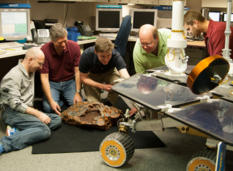
Bringing Mars home
Researcher Kris Capraro adds the finishing touches of realistic color to a model of the Block Island meteorite, while team members look on. The real Block Island probably weighs about a half ton. The realistic model, on the other hand, you could carry under one arm. But it sure looks heavy.NASA / JPL-Caltech
As April turns to May, the plan ahead calls for Opportunity to spend a couple of sols remote sensing and then move in on the new site and figure out what to look at first.
At Cook Haven, Opportunity roved over no end of impact breccia and "serendipitously" found evidence for "post breccia deposition alteration," in the "jelly doughnut" rock called Pinnacle Island, as Arvidson summed it up. "That indicates that aqueous processes have been operating for a long time on Endeavour's rim," he said.
The robot field geologist however was unable to find any of the oldest strata at Cook Haven, that is Matijevic Formation rocks first found nearly two years ago with the flat, light-toned rock, Whitewater Lake at Matijevic Hill, in the Cape York section of Endeavour's eroded rim. "By projecting from where we found it at Matijevic Hill, it was maybe 10 meters further beneath the rover's wheels," said Arvidson.
The really ancient Noachian Matijevic Formation rocks may be out of reach at the new site too, where outcrops harboring the montmorillonites are "likely to also be impact breccia," said Arvidson. "The glass in the breccia there has probably been altered and I don't think we'll see older, Matijevic Formation stuff until we get to this mother lode valley in Cape Tribulation, which is still about 3 kilometers away." Even so, whatever they find there, it will add to the story of past water environments at Endeavour.
As excited as they are to be pulling into a new site, which at post time was still without a name, MER team members are even more anxious to get Opportunity to that mother lode at Cape Tribulation. They have been eyeing Cape Tribulation since arriving at Endeavour in August 2011. With its lucky star in tow and an approved mission extension budget, they have every intention of doing just that.
There are no guarantees on Mars any more than there are on Earth. The MER team knows well that as Mars taketh, it also giveth. "The power is really good now, but we're approaching the season in which the atmosphere becomes dusty and starts to rain stuff out," reminded Callas. "In that sense, we could have a longer, dusty period ahead of us."
But for now, the outlook and the future still looks incredibly bright. "Opportunity is an amazing rover," said Stroupe. "Yes, this rover is 10 years old and anything can go wrong and there can be any number of problems, but you've got to plan for success. We keep in mind something could go wrong, but we plan for success. That's how we focus. Right now, we're planning for success and looking forward."
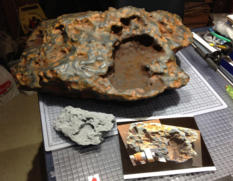
3D Model of Block Island
The Block Island meteorite, reproduced at NASA’s Jet Propulsion Laboratory with data and images sent home by Opportunity and the new technology of 3D printing, got its finishing touches in April 2014. The real Block Island on Mars is in the picture in front of the iron nickel rock.NASA / JPL-Caltech
Meanwhile, down on Earth, a team at JPL led by Kris Capraro, who primarily creates navigation maps of the Martian surface for planning rover drive paths, put the finishing touches on a true facsimile of Block Island, the largest meteorite found on Mars to date, which they replicated with a 3D printer.
Although most meteorites break up when hitting the ground because today's Martian atmosphere is not dense enough to slow them down enough, Block Island, which is the size of a large watermelon or a small ice chest, defies that rule. Scientists theorize that it could have landed on Mars intact only if it had a very specific entry point into the atmosphere and a very shallow flight path. That would slow it down enough to keep it from breaking apart on landing. Or it just may be really, really ancient, arriving back when Mars had more of an atmosphere.
In any case, Opportunity found Block Island back in August 2009 and took detailed measurements and dozens of pictures, including stereo images, during a 360-degree study of the iron-nickel gem. This is the data Capraro and team used to create the life-size replica.
Since the rover could not see every square inch of Block Island – like the bottom of it which rests on the Martian ground – the first attempts to create a model did not succeed. Missing data created holes in the computer model and that made it unfit for 3D printing [stereolithography], which builds the model from a spool of common plastic called ABS, for acrylonitrile butadiene styrene.
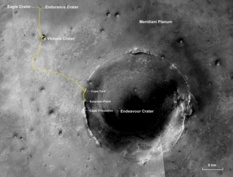
The adventure so far
The gold line on this image shows Opportunity's route from her landing site, Eagle Crater, upper left, to the areas has been recently investigating on Murray Ridge in the Solander Point section of the western rim of Endeavour Crater. The base image for the map is a mosaic of images taken by the Context Camera on MRO, built and operated by Malin Space Science Systems. This traverse map was made by Larry Crumpler, a MER science team member, of the New Mexico Museum of Natural History & Science, Albuquerque.NASA / JPL-Caltech / MSSS / NMMNHS
Then last summer, researchers solved the problem of how to fill in missing data. Capraro and the team applied software methods usually used to help navigate the rover to create depth meshes of the meteorite's surface from six positions, then combined them into a three-dimensional digital model. From that, they built several small models of the meteorite. "Holding one of these small models in your hand was very cool," said Capraro, "but to experience the meteorite that lay before Opportunity, it had to be big – an actual-size model of the meteorite."
Since Block Island is bigger than the 3D printer's building space, the researchers had to break up the computer model into 11 sections. It took 305 hours and 36 minutes to print the parts. After assembling all of the sections, they finished the model by painting it to match the real meteorite's color based on rover images.
"This is the first time that an object on another world has been fully documented in 3D and then physically rendered in 3D on the surface of the Earth," said Callas. "So in a sense, we teleported Block Island down to the Earth via this technique of stereo imaging, multiple views, and then 3D printing," said Callas. "It is an end-to-end demonstration of the technological capabilities that now exist."
It's one thing to say you can do something like this and another to actually do it – "to make sure all the pieces work and all the interfaces exist and the data set is complete and you have the tools to properly interpret it," Callas added. "You can put this [Block Island replica] on your desk and walk around it and look at it and say, 'Wow.' It allows us to physio-virtually hold a piece of Mars here on Earth, a piece of Mars that was investigated by a rover on the surface of the Red Planet."
Cooler still, the real Block Island probably weighs a half-ton, but its "stunt double" is so light, you could easily carry it under your arm.
This achievement opens the door for other detailed models of rocks and terrain on Mars or elsewhere in the solar system and Capraro and the researcher expect the technology will also find uses in other applications on Earth, such as life-size 3D reproductions of remote objects or settings. Right now, said Capraro, "it's the next best thing to bringing back real Martian rock samples back to Earth."
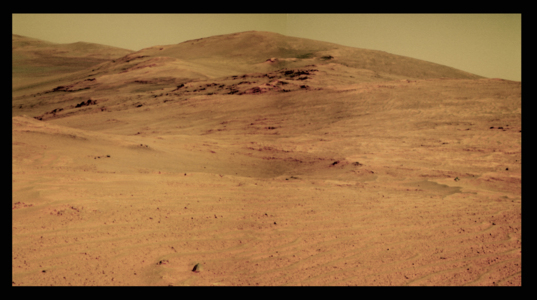
photo_credit
Cape Tribulation
Stuart Atkinson, MER poet and member of UMSF.com, processed Pancam pictures that Opportunity took in April into this near true color image of Cape Tribulation. A mother lode of different kinds of clay minerals and other Martian surprise, no doubt, await Opportunity and the team there. For more of Atkinson's work, visit his blog The Road to Endeavour.Support our core enterprises
Your support powers our mission to explore worlds, find life, and defend Earth. You make all the difference when you make a gift. Give today!
Donate

 Explore Worlds
Explore Worlds Find Life
Find Life Defend Earth
Defend Earth


